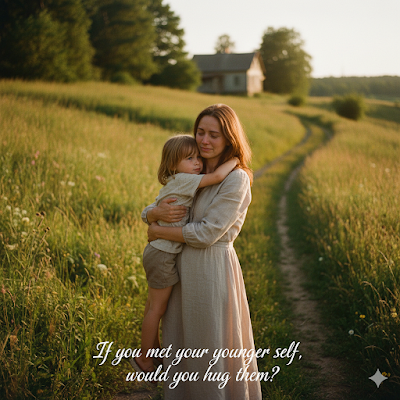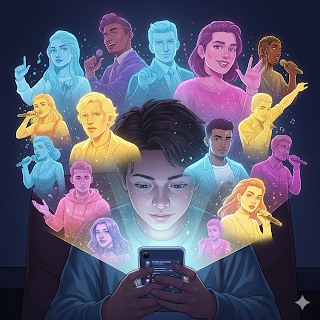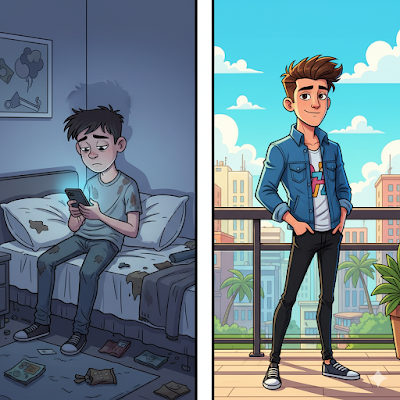Self-Perception Psychology: Would You Hug Your Younger Self?
If You Met Your Younger Self, Would You Hug Them? Exploring Self-Perception and Emotional Healing
This article is based on a mini-study I did in September 2025, where I asked forty people a single question — “If you met your younger self, would you hug them?”
Yeah, sounds sentimental, but under that softness sits something real — how we see ourselves, how we heal, and how we measure growth. Sometimes imagination becomes a psychology lab.
What Is Self-Perception in Psychology?
Self-perception is basically the mirror we hold up to our past selves. It’s how we see our worth and continuity across time.
For some, that younger self feels connected — like a timeline that still makes sense. For others, it’s like facing a total stranger. That emotional gap is what psychologists call self-fragmentation, where your past and present selves feel out of sync.
Related: Is Mindless Scrolling Numbing Us?
When people answered my question, their responses showed it all — warmth, anger, humor, regret. The patterns said a lot about emotional growth and how trauma shapes our self-talk.
Some felt aligned with who they used to be — a straight emotional thread. Others? Total disconnection, like their younger self was another species.
That’s the modern fragmentation of identity. We’re evolving so fast, through tech and emotional chaos, that the past version of us feels… outdated.
Voices from the Reflection
People’s reactions fell into clear vibes — emotional archetypes, each showing a different flavor of self-perception.
Some were soft.
“I’d hug her — not pity, not sympathy, just respect for trying.”
Others were like, nah fam.
“I’d slap them for being foolish.”
Funny thing? That humor was hiding pain. That’s how people defend themselves — by laughing first, feeling later.
And then there were the ones who went all spiritual with it — saying they’d hug the version of themselves who was “pure” or “close to God.” For them, it wasn’t just emotional. It was redemption.
Self-Perception in Digital World:
Our past selves don’t just live in memories anymore — they’re archived online.
Old photos, captions, tweets — all those versions still exist.
When we talk about hugging our younger selves, we’re also talking about forgiving our digital ghosts — the posts we cringe at, the phases we can’t delete.
Related: How to Overcome Overthinking?
So yeah, maybe the hug isn’t just emotional. It’s digital self-reconciliation — finally stopping the hate toward our own archived selves.
The Five Archetypes of Self-Perception
Let’s break down the main patterns that popped up.
1. The Reconciler
The chill ones. They’d totally hug their younger self, no hesitation. Their energy screams healing.
They’re like, “Love and forgiveness — that’s it.”
They’ve learned that imperfection isn’t failure; it’s just growth with texture.
2. The Critic
Oof, the harsh ones. Their replies? Brutally honest, sometimes darkly funny.
Stuff like: “I’d slap him and throw him out the window. He faced what he had to.”
That’s not cruelty — it’s fatigue. Self-hate built from survival.
3. The Idealist
These are the nostalgia kids. They miss who they used to be — the spark, the simplicity.
“I miss the old me; she laughed easily.”
They’d hug that younger self just to feel that peace again.
4. The Spiritual Reflector
Their responses were deep — tied to faith, forgiveness, divine mercy.
Stuff like: “I’d hug the version of me who prayed every night and thank God for keeping me.”
For them, the hug’s not just human — it’s holy.
5. The Observer
Cool-headed analyzers. They don’t get emotional; they just observe.
“Different times have different meanings. I’d love her for her time, not for comparison.”
It’s not detachment — it’s emotional distance, the kind that comes with time and reflection.
Emotional Patterns and Real Voices
Here’s a taste of what people actually said:
-
“I’d hug her and tell her she did great.”
-
“I’d slap him; he needed to learn faster.”
-
“I’d thank God and myself for not giving up.”
-
“I would hug her because no one else did.”
-
“I’d just observe. That version isn’t me anymore.”
See the mix? Some are full of empathy. Some are heavy. Some hover in between. That’s the human spectrum — from self-love to exhaustion to neutrality.
How Time Changes Emotion
One of the coolest takeaways? Time softens emotions.
People who once hated their past selves now talk about them like distant characters in a movie. That’s emotional intelligence in motion — reacting less, understanding more.
But yeah, some still can’t forgive their younger selves, and that’s okay too. Healing doesn’t come with a timer.
Between Love and Distance
At the end of the day, everyone — whether they’d hug, slap, or ignore their past self — shared one thing: awareness.
Even the ones who said “I wouldn’t hug” still acknowledged that child.
That’s growth — understanding that every version of you existed for a reason.
Like one person put it:
“Different times have different meanings. I’d love her for her time, not for comparison.”
That’s high-level self-compassion right there — not judging your past self with your present mind.
The Mirror of Continuity
This whole reflection isn’t just about nostalgia. It’s about emotional continuity — understanding that your story never really resets.
Whether you’d hug your younger self or not, the real question is:
Have you made peace with them?
Because maybe the hug doesn’t happen literally. Maybe it happens when you stop resenting your history and start understanding it.
That’s the quiet moment where the real healing starts.
Conclusion: The Quiet Embrace
At last, this isn’t really about the hug — it’s about peace.
It’s about questioning, “Have I made peace with the person who began my story?”
Related: Why Gen Z laughs through Stress?
Some people hug, some hesitate, some analyze. But every response, no matter how messy, reveals emotional evolution.
Maybe we never literally hug that version of ourselves.
But every time we stop hating who we were, every time we forgive the old us for not knowing better — that’s the metaphorical hug.
That moment — silent, unseen, but deeply psychological — is the true embrace.
Final Thoughts:
Change is constant. The hug — literal or not — is just the checkpoint. It’s where you realize you’ve survived, grown, and maybe, just maybe, started to forgive the person who started it all.










Really loved it
Glad you liked it!❤️